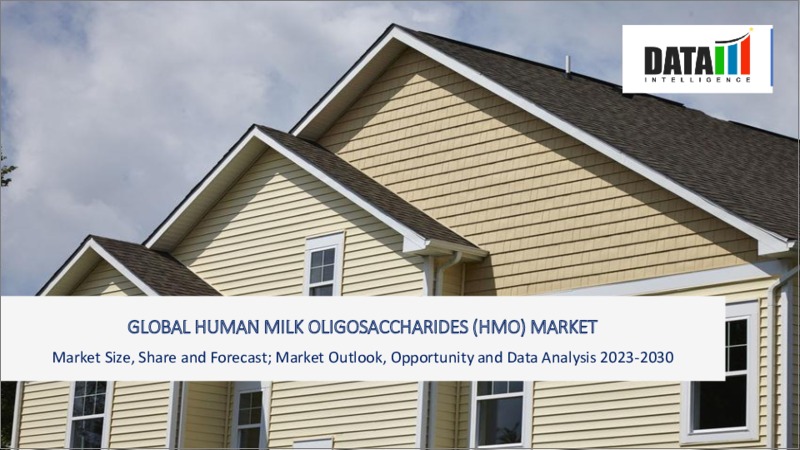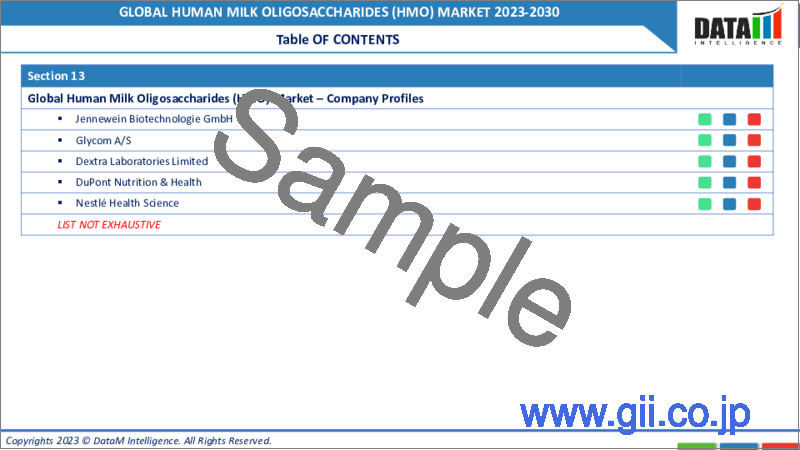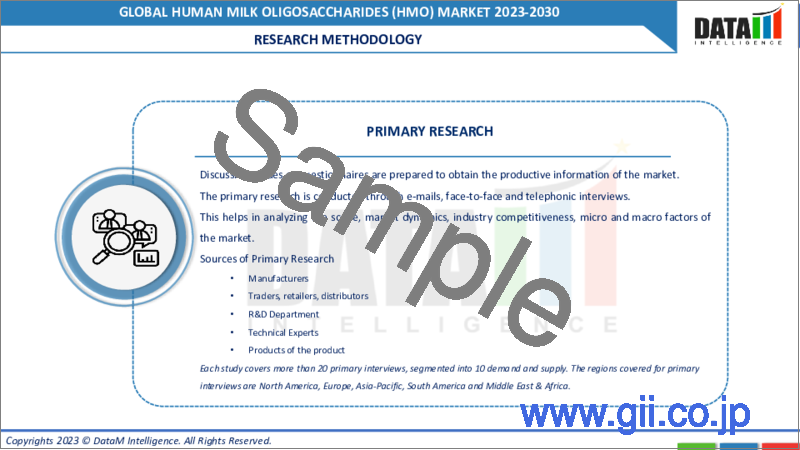|
|
市場調査レポート
商品コード
1319215
ヒトミルクオリゴ糖(HMO)の世界市場-2023年~2030年Global Human Milk Oligosaccharides Market - 2023-2030 |
||||||
|
● お客様のご希望に応じて、既存データの加工や未掲載情報(例:国別セグメント)の追加などの対応が可能です。 詳細はお問い合わせください。 |
|||||||
| ヒトミルクオリゴ糖(HMO)の世界市場-2023年~2030年 |
|
出版日: 2023年07月31日
発行: DataM Intelligence
ページ情報: 英文 102 Pages
納期: 約2営業日
|
- 全表示
- 概要
- 目次
市場概要
世界のヒトミルクオリゴ糖(HMO)市場は、2022年に1億9,650万米ドルと評価され、2030年には8億5,050万米ドルに達し、有利な成長を示すと予測されています。市場は予測期間2023-2030年に20.1%のCAGRで成長する見通しです。
HMOは、免疫系をサポートし、腸の健康を促進し、認知発達を助けることが知られています。ヘルスケア専門家や消費者の間で認識が広まるにつれて、乳児、小児、成人を含む様々な年齢層でHMOに基づく製品に対する需要が高まっています。
HMOは、有益な腸内細菌の増殖を選択的に刺激するため、プレバイオティクスとみなされます。HMOのプレバイオティクス特性は、腸内細菌叢への影響と関連する健康上の利点に焦点を当てた研究が増加し、市場で注目されています。腸-脳軸の理解と全体的な幸福における腸の健康の役割は、プレバイオティクス成分としてのHMOへの関心をさらに高める。
市場力学
乳児人口の増加がヒトミルクオリゴ糖(HMO)の市場成長を促進します
世界の出生率は世界的に増加しています。国連によると、毎日385,000人の新生児が生まれています。これは年間合計で1億4,000万人以上です。この出生率の増加は、適切な栄養を必要とする乳幼児の人口増加につながります。親が乳児の栄養ニーズをより意識するようになるにつれて、HMOを強化したものを含む乳児用調製粉乳やその他の乳児栄養製品に対する需要が高まっています。
特に、歴史的に母乳育児の割合が低かった地域では、乳児への授乳方法に変化が生じています。都市化、ライフスタイルの変化、働く母親の増加などの要因が、乳児用調製粉乳の使用を含む代替授乳方法の増加に寄与しています。その結果、ヒト母乳の組成と利点に酷似した粉ミルク製品に対する需要が増加し、これにはHMOの組み入れも含まれます。
HMOの利点に対する認識がヒトミルクオリゴ糖(HMO)市場の成長を促進しています
HMOはヒト母乳に含まれる天然成分であり、乳児に多くの健康上の利益をもたらすことが示されています。それらは、消化、栄養吸収および免疫系の発達に重要な役割を果たす健康な腸内細菌叢の発達をサポートします。HMOはまた、感染症、アレルギー、および特定の疾病のリスク軽減と関連しています。これらの利点に対する認識が高まるにつれて、両親とヘルスケア専門家は、最適な栄養を提供し、乳児の健康をサポートするために、積極的にHMOベースの製品を求めています。
健康全般における健康な腸内細菌叢の重要性が認識されつつあります。HMOはプレバイオティクスとして働き、ビフィズス菌などの有益な腸内細菌に選択的に栄養を与えます。有害な病原体の増殖を抑制しながら、これらの有益な細菌の増殖を促進します。免疫機能や認知開発を含む健康の様々な側面における腸内細菌叢の重要な役割が研究により明らかにされ続ける中、健康な腸内細菌叢をサポートする手段としてのHMOに対する認識と需要は高まっています。
規制および知的所有権の問題はヒトミルクオリゴ糖(HMO)市場の成長を妨げる可能性があります
食品および栄養補助食品に使用されるHMOは、米国食品医薬品局(FDA)や欧州食品安全機関(EFSA)などの管理機関が定めた規制要件を遵守しなければならないです。これらの規制は、HMOに基づく製品に関連する安全性、表示および健康強調表示などの側面を規制します。これらの規制を満たすことは複雑で時間がかかり、相当な資源と専門知識を必要とします。規制当局の承認取得の困難は、製品の上市を遅らせ、またはHMOに基づく製品の市場参入を制限する可能性があります。
知的財産権は、技術革新および市場競争において重要な役割を果たします。企業は、新規 HMO組成物、製造工程および用途を創出するための研究開発努力に投資します。特許の取得はこれらの革新を保護し、企業に独占権と競争上の優位性を提供します。しかしながら、重大な特許紛争、法的課題、または専有技術の使用制限がある場合、知的財産の問題は市場の成長を妨げる可能性があります。これは新規参入を制限し、革新的なHMOベース製品の開発を妨げる可能性があります。
COVID-19影響分析
COVID-19分析には、COVID前シナリオ、COVIDシナリオ、COVID後シナリオ、価格力学(COVID前シナリオと比較したパンデミック中およびパンデミック後の価格変動を含む)、需給スペクトラム(取引制限、封鎖、およびその後の問題による需要と供給のシフト)、政府の取り組み(政府機関による市場、分野、または産業を活性化させる取り組み)、メーカーの戦略的取り組み(COVID問題を緩和するためにメーカーが行ったこと)が含まれます。
目次
第1章 調査手法と調査範囲
第2章 定義と概要
第3章 エグゼクティブサマリー
第4章 市場力学
- 影響要因
- 促進要因
- 抑制要因
- 機会
- 影響分析
第5章 産業分析
- ポーターのファイブフォース分析
- サプライチェーン分析
- 価格分析
- 規制分析
第6章 COVID-19分析
第7章 製品別
- ラクト-N-ネオテトラオース(LNnT)
- ラクト-N-テトラオース(LNT)
- 2'-フコシラクトース(2'FL)
- 3'-フコシラクトース(3'FL)
- 3'-シアリルラクトース(3'SL)
- 6'-シアリルラクトース(6'SL)
- その他
第8章 タイプ別
- 中性
- 酸性
- その他
第9章 用途別
- 乳児用調製粉乳
- 栄養補助食品
- 機能性飲食品
- その他
第10章 地域別
- 北米
- 米国
- カナダ
- メキシコ
- 欧州
- ドイツ
- 英国
- フランス
- イタリア
- スペイン
- その他欧州
- 南米
- ブラジル
- アルゼンチン
- その他南米
- アジア太平洋
- 中国
- インド
- 日本
- オーストラリア
- その他アジア太平洋地域
- 中東・アフリカ
第11章 競合情勢
- 競合シナリオ
- 市況/シェア分析
- M&A分析
第12章 企業プロファイル
- Elicityl SA
- 会社概要
- 製品ポートフォリオと説明
- 財務概要
- 主な発展
- Medolac Laboratories
- Inbiose NV
- Glycosyn
- ZuChem
- Jennewein Biotechnologie GmbH
- Glycom A/S
- Dextra Laboratories Limited
- DuPont Nutrition & Health
- Nestle Health Science
第13章 付録
Market Overview
The Global Human Milk Oligosaccharides (HMO) Market was valued US$ 196.5 million in 2022 and is projected to witness lucrative growth by reaching up to US$ 850.5 million by 2030. The market is growing at a CAGR of 20.1% during the forecast period 2023-2030.
HMOs are known to support the immune system, promote gut health, and aid in cognitive development. As awareness spreads among healthcare professionals and consumers, there is a rising demand for HMO-based products across various age groups, including infants, children, and adults.
HMOs are considered prebiotics as they selectively stimulate the growth of beneficial gut bacteria. The prebiotic properties of HMOs are gaining attention in the market, with increased research focusing on their impact on gut microbiota and associated health benefits. The understanding of the gut-brain axis and the role of gut health in overall well-being further drive the interest in HMOs as prebiotic ingredients.
Market Dynamics
The Rising Infant Population is Driving the Market Growth of Human Milk Oligosaccharides (HMO)
The global birth rate has been increasing globally. According to the UN 385,000 newborns are born every day. That totals more than 140 million annually. This higher birth rate leads to a larger population of infants requiring proper nutrition. As parents become more conscious of the nutritional needs of their infants, there is a growing demand for infant formula and other infant nutrition products, including those enriched with HMOs.
There has been a shift in infant feeding practices, particularly in regions where breastfeeding rates have historically been low. Factors such as urbanization, changing lifestyles, and the increasing number of working mothers contribute to the rise in alternative feeding methods, including the use of infant formula. As a result, there is an increased demand for formula products that closely resemble the composition and benefits of human breast milk, which includes the incorporation of HMOs.
Awareness of HMO Benefits is Driving Human Milk Oligosaccharides (HMO) Market Growth
HMOs are natural components found in human breast milk and have been shown to provide numerous health benefits to infants. They support the development of healthy gut microbiota, which plays a crucial role in digestion, nutrient absorption, and immune system development. HMOs are also associated with reduced risks of infections, allergies, and certain diseases. As awareness of these benefits grows, parents and healthcare professionals actively seek out HMO-based products to provide optimal nutrition and support the health of infants.
There is increasing recognition of the importance of healthy gut microbiota in overall well-being. HMOs act as prebiotics, selectively nourishing beneficial gut bacteria, such as Bifidobacteria. They promote the growth of these beneficial bacteria while inhibiting the growth of harmful pathogens. As research continues to unveil the significant role of the gut microbiota in various aspects of health, including immune function and cognitive development, the awareness and demand for HMOs as a means to support healthy gut microbiota is growing.
Regulatory and Intellectual Property Issues can Hamper the Growth of the Human Milk Oligosaccharides (HMO) Market
HMOs used in food and dietary supplement products must adhere to regulatory requirements set by governing bodies, such as the U.S. Food and Drug Administration (FDA) and the European Food Safety Authority (EFSA). These regulations govern aspects such as safety, labeling, and health claims associated with HMO-based products. Meeting these regulations can be complex and time-consuming, requiring substantial resources and expertise. Difficulties in obtaining regulatory approvals may delay product launches or limit the market entry of HMO-based products.
Intellectual property rights play a crucial role in innovation and market competition. Companies invest in research and development efforts to create novel HMO compositions, manufacturing processes, and applications. Obtaining patents protects these innovations and provides companies with exclusivity and competitive advantage. However, intellectual property issues can hamper market growth if there are significant patent disputes, legal challenges, or restrictions on the use of proprietary technologies. This can limit the entry of new players and hinder the development of innovative HMO-based products.
COVID-19 Impact Analysis
The COVID-19 Analysis includes Pre-COVID Scenario, COVID Scenario, and Post-COVID Scenario along with Pricing Dynamics (Including pricing change during and post-pandemic comparing it to pre-COVID scenarios), Demand-Supply Spectrum (Shift in demand and supply owing to trading restrictions, lockdown, and subsequent issues), Government Initiatives (Initiatives to revive market, sector or Industry by Government Bodies) and Manufacturers Strategic Initiatives (What manufacturers did to mitigate the COVID issues will be covered here).
Segment Analysis
The global human milk oligosaccharides (HMO) market is segmented based on product, type, application, and region.
Abundance of 2'-Fucosyllactose (2'FL) in Human Milk
The global Human Milk Oligosaccharides (HMO) market has been segmented by Infant Formula, Dietary Supplements, Functional Food & Beverages, Others
In 2022, based on application, the infant formula held the highest share of the Human Milk Oligosaccharides (HMO) market.
The global demand for infant formula has been steadily increasing, driven by factors such as urbanization, changing lifestyles, and the rise in the number of working mothers. According to the Babytree/Nielsen research Infant formula makes up the great bulk of the baby care market, accounting for 72% of all sales. With more parents opting for infant formula as an alternative to breastfeeding, the demand for high-quality and nutritionally enriched formulas, including those containing HMOs, has risen significantly.
Infant formula serves as a substitute for breast milk components when breastfeeding is not possible or insufficient. HMOs are an essential component of breast milk, contributing to various health benefits for infants, including supporting the immune system, gut health, and cognitive development. The inclusion of HMOs in infant formula is aimed at providing similar benefits and promoting the growth and development of formula-fed infants.
Geographical Analysis
Growing Health Consciousness in North America Regions
In 2022, the North American region had a significant share of the Human Milk Oligosaccharides (HMO) market. North America has a well-established healthcare infrastructure and advanced research and development capabilities. The region is home to several prominent pharmaceutical and nutrition companies that are actively engaged in HMO research and product development. The strong healthcare infrastructure facilitates the production, distribution, and marketing of HMO-based products, contributing to the region's significant market share.
North America is home to several key market players in the HMO industry, including manufacturers, suppliers, and distributors. These companies have the expertise, resources, and market reach to drive the growth of HMO-based products in the region. The presence of established market players strengthens the market position of North America in the HMO industry.
Competitive Landscape
The major global players in the market include: Elicityl SA, Medolac Laboratories, Inbiose NV, Glycosyn, ZuChem, Jennewein Biotechnologie GmbH, Glycom A/S, Dextra Laboratories Limited, DuPont Nutrition & Health, Nestle Health Science
Why Purchase the Report?
- To visualize the global human milk oligosaccharides (HMO) market segmentation based on product, type, application and region, as well as understand key commercial assets and players.
- Identify commercial opportunities by analyzing trends and co-development.
- Excel data sheet with numerous data points of human milk oligosaccharides (HMO) market-level with all segments.
- PDF report consists of a comprehensive analysis after exhaustive qualitative interviews and an in-depth study.
- Product mapping available as excel consisting of key products of all the major players.
The Global Human Milk Oligosaccharides (HMO) Market Report Would Provide Approximately 61 Tables, 63 Figures, and 102 Pages.
Target Audience 2023
- Manufacturers/ Buyers
- Industry Investors/Investment Bankers
- Research Professionals
- Emerging Companies
Table of Contents
1. Methodology and Scope
- 1.1. Research Methodology
- 1.2. Research Objective and Scope of the Report
2. Definition and Overview
3. Executive Summary
- 3.1. Snippet by Product
- 3.2. Snippet by Type
- 3.3. Snippet by Application
- 3.4. Snippet by Region
4. Dynamics
- 4.1. Impacting Factors
- 4.1.1. Drivers
- 4.1.2. Restraints
- 4.1.3. Opportunity
- 4.1.4. Impact Analysis
5. Industry Analysis
- 5.1. Porter's Five Force Analysis
- 5.2. Supply Chain Analysis
- 5.3. Pricing Analysis
- 5.4. Regulatory Analysis
6. COVID-19 Analysis
- 6.1. Analysis of COVID-19
- 6.1.1. Scenario Before COVID
- 6.1.2. Scenario During COVID
- 6.1.3. Scenario Post COVID
- 6.2. Pricing Dynamics Amid COVID-19
- 6.3. Demand-Supply Spectrum
- 6.4. Government Initiatives Related to the Market During Pandemic
- 6.5. Manufacturers Strategic Initiatives
- 6.6. Conclusion
7. By Product
- 7.1. Introduction
- 7.1.1. Market Size Analysis and Y-o-Y Growth Analysis (%), By Product
- 7.1.2. Market Attractiveness Index, By Product
- 7.2. Lacto-N-neotetraose (LNnT) *
- 7.2.1. Introduction
- 7.2.2. Market Size Analysis and Y-o-Y Growth Analysis (%)
- 7.3. Lacto-N-tetraose (LNT)
- 7.4. 2'-Fucosyllactose (2'FL)
- 7.5. 3'-Fucosyllactose (3'FL)
- 7.6. 3'-Sialyllactose (3'SL)
- 7.7. 6'-Sialyllactose (6'SL)
- 7.8. Others
8. By Type
- 8.1. Introduction
- 8.1.1. Market Size Analysis and Y-o-Y Growth Analysis (%), By Type
- 8.1.2. Market Attractiveness Index, By Type
- 8.2. Neutral*
- 8.2.1. Introduction
- 8.2.2. Market Size Analysis and Y-o-Y Growth Analysis (%)
- 8.3. Acidic
- 8.4. Others
9. By Application
- 9.1. Introduction
- 9.1.1. Market Size Analysis and Y-o-Y Growth Analysis (%), By Application
- 9.1.2. Market Attractiveness Index, By Application
- 9.2. Infant Formula*
- 9.2.1. Introduction
- 9.2.2. Market Size Analysis and Y-o-Y Growth Analysis (%)
- 9.3. Dietary Supplements
- 9.4. Functional Food & Beverages
- 9.5. Others
10. By Region
- 10.1. Introduction
- 10.1.1. Market Size Analysis and Y-o-Y Growth Analysis (%), By Region
- 10.1.2. Market Attractiveness Index, By Region
- 10.2. North America
- 10.2.1. Introduction
- 10.2.2. Key Region-Specific Dynamics
- 10.2.3. Market Size Analysis and Y-o-Y Growth Analysis (%), By Product
- 10.2.4. Market Size Analysis and Y-o-Y Growth Analysis (%), By Type
- 10.2.5. Market Size Analysis and Y-o-Y Growth Analysis (%), By Application
- 10.2.6. Market Size Analysis and Y-o-Y Growth Analysis (%), By Country
- 10.2.6.1. The U.S.
- 10.2.6.2. Canada
- 10.2.6.3. Mexico
- 10.3. Europe
- 10.3.1. Introduction
- 10.3.2. Key Region-Specific Dynamics
- 10.3.3. Market Size Analysis and Y-o-Y Growth Analysis (%), By Product
- 10.3.4. Market Size Analysis and Y-o-Y Growth Analysis (%), By Type
- 10.3.5. Market Size Analysis and Y-o-Y Growth Analysis (%), By Application
- 10.3.6. Market Size Analysis and Y-o-Y Growth Analysis (%), By Country
- 10.3.6.1. Germany
- 10.3.6.2. The UK
- 10.3.6.3. France
- 10.3.6.4. Italy
- 10.3.6.5. Spain
- 10.3.6.6. Rest of Europe
- 10.4. South America
- 10.4.1. Introduction
- 10.4.2. Key Region-Specific Dynamics
- 10.4.3. Market Size Analysis and Y-o-Y Growth Analysis (%), By Product
- 10.4.4. Market Size Analysis and Y-o-Y Growth Analysis (%), By Type
- 10.4.5. Market Size Analysis and Y-o-Y Growth Analysis (%), By Application
- 10.4.6. Market Size Analysis and Y-o-Y Growth Analysis (%), By Country
- 10.4.6.1. Brazil
- 10.4.6.2. Argentina
- 10.4.6.3. Rest of South America
- 10.5. Asia-Pacific
- 10.5.1. Introduction
- 10.5.2. Key Region-Specific Dynamics
- 10.5.3. Market Size Analysis and Y-o-Y Growth Analysis (%), By Product
- 10.5.4. Market Size Analysis and Y-o-Y Growth Analysis (%), By Type
- 10.5.5. Market Size Analysis and Y-o-Y Growth Analysis (%), By Application
- 10.5.6. Market Size Analysis and Y-o-Y Growth Analysis (%), By Country
- 10.5.6.1. China
- 10.5.6.2. India
- 10.5.6.3. Japan
- 10.5.6.4. Australia
- 10.5.6.5. Rest of Asia-Pacific
- 10.6. Middle East and Africa
- 10.6.1. Introduction
- 10.6.2. Key Region-Specific Dynamics
- 10.6.3. Market Size Analysis and Y-o-Y Growth Analysis (%), By Product
- 10.6.4. Market Size Analysis and Y-o-Y Growth Analysis (%), By Type
- 10.6.5. Market Size Analysis and Y-o-Y Growth Analysis (%), By Application
11. Competitive Landscape
- 11.1. Competitive Scenario
- 11.2. Market Positioning/Share Analysis
- 11.3. Mergers and Acquisitions Analysis
12. Company Profiles
- 12.1. Elicityl SA*
- 12.1.1. Company Overview
- 12.1.2. Product Portfolio and Description
- 12.1.3. Financial Overview
- 12.1.4. Key Developments
- 12.2. Medolac Laboratories
- 12.3. Inbiose NV
- 12.4. Glycosyn
- 12.5. ZuChem
- 12.6. Jennewein Biotechnologie GmbH
- 12.7. Glycom A/S
- 12.8. Dextra Laboratories Limited
- 12.9. DuPont Nutrition & Health
- 12.10. Nestle Health Science
LIST NOT EXHAUSTIVE
13. Appendix
- 13.1. About Us and Services
- 13.2. Contact Us




